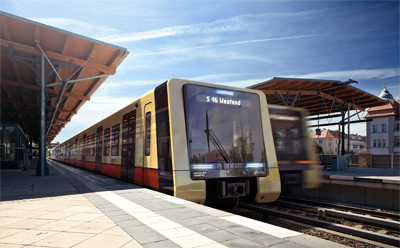New trains for Berlin’s S-Bahn

A firm order was placed for the first 106 trains. The 85 four-section and 21 two-section trains have a high triple-digit million-euro order volume.
S-Bahn Berlin plans to use the new trains on the Ringbahn lines (S 41 and S 42) as well as on the system’s southeastern feeder lines S 47, S 46 and S 8.
These lines comprise roughly one-third of the entire S-Bahn network in Berlin.
The first ten vehicles will be ready to enter service as of 2020. Subsequently, all remaining vehicles will be delivered continuously to the Berlin system up to 2023.
The vehicles will be manufactured and assembled at the Berlin plant operated by Stadler Pankow GmbH, part of Stadler Rail Group- a systems supplier of customer-specific solutions for rail vehicle construction.
“Siemens and Stadler are offering a unique combination of competencies for the future of S-Bahn Berlin. Both companies are deeply rooted in Berlin, and together we will deliver vehicles that will operate with the highest reliability and be top-class technically,” said Sabrina Soussan, head of Siemens’ business with high-speed and regional trains and locomotives.
The vehicles will have a modern exterior design while remaining loyal to the traditional and trusted yellow and red colours of the Berlin S-Bahn.
Along with powerful traction and control systems that ensure highly efficient and quiet operation, the main innovations will be in the interior.
The cars will feature a modern passenger information system and provide a spacious and comfortable environment for passengers.
For the first time in Berlin, the trains will be equipped with air conditioning. In addition, the cars will offer space for wheelchairs located directly behind the driver.
Consortium leader Stadler will be responsible for the mechanical and structural aspects of the construction and production, including, for example, the air conditioning system and assembly of all components.
Siemens will be responsible for the electrical equipment, including the propulsion and braking systems, on-board power supply system, vehicle and train control systems, passenger information system and vehicle bogies.
Maintenance of the trains will be provided by S-Bahn Berlin GmbH, which will use its existing infrastructure.
What the stars mean:
★ Poor ★ ★ Promising ★★★ Good ★★★★ Very good ★★★★★ Exceptional
Latest News
More News
- Businesses ramp up production as year-end orders surge (December 30, 2025 | 10:05)
- Vietjet chairwoman awarded Labour Hero title (December 29, 2025 | 13:06)
- How to unlock ESG value through green innovation (December 29, 2025 | 10:03)
- AI reshapes media and advertising industry (December 29, 2025 | 08:33)
- FPT and GELEX sign deal to develop blockchain tech for global markets (December 29, 2025 | 08:29)
- Vietnam’s GDP forecast to grow by 9 per cent in 2026 (December 29, 2025 | 08:29)
- Women entrepreneurs are key to Vietnam’s economic growth (December 29, 2025 | 08:00)
- Vietnam's top 500 value-creating enterprises announced (December 27, 2025 | 08:00)
- The PAN Group shaping a better future with ESG strategy (December 26, 2025 | 09:00)
- Masan Consumer officially lists on HSX, marking the next phase of value creation (December 25, 2025 | 13:20)

















 Mobile Version
Mobile Version